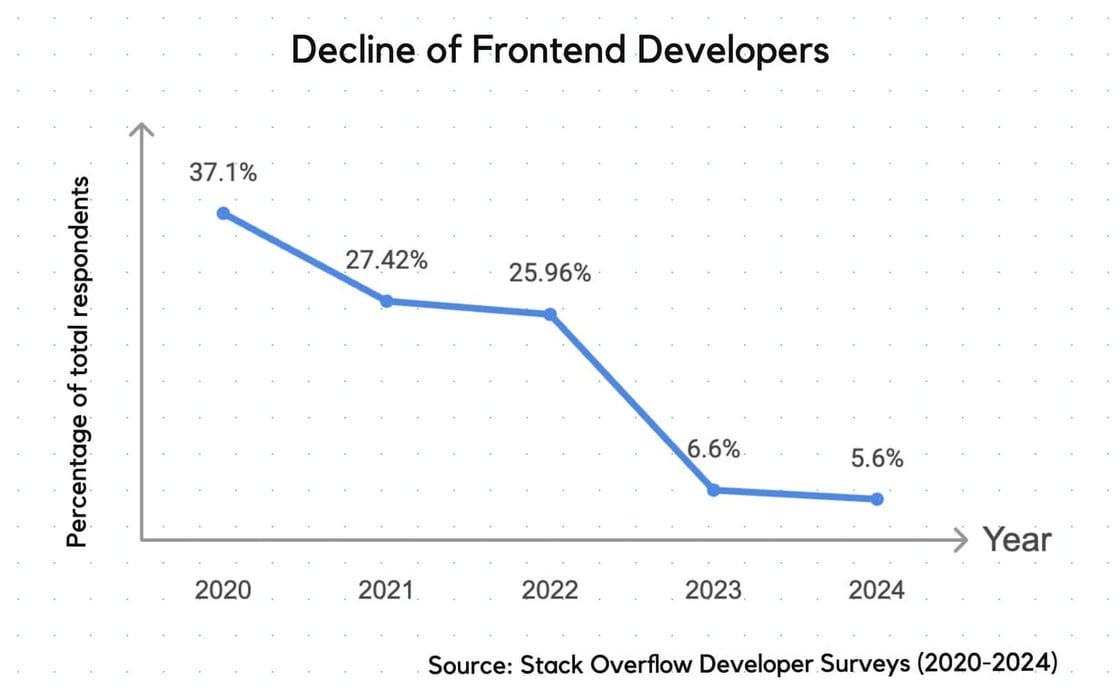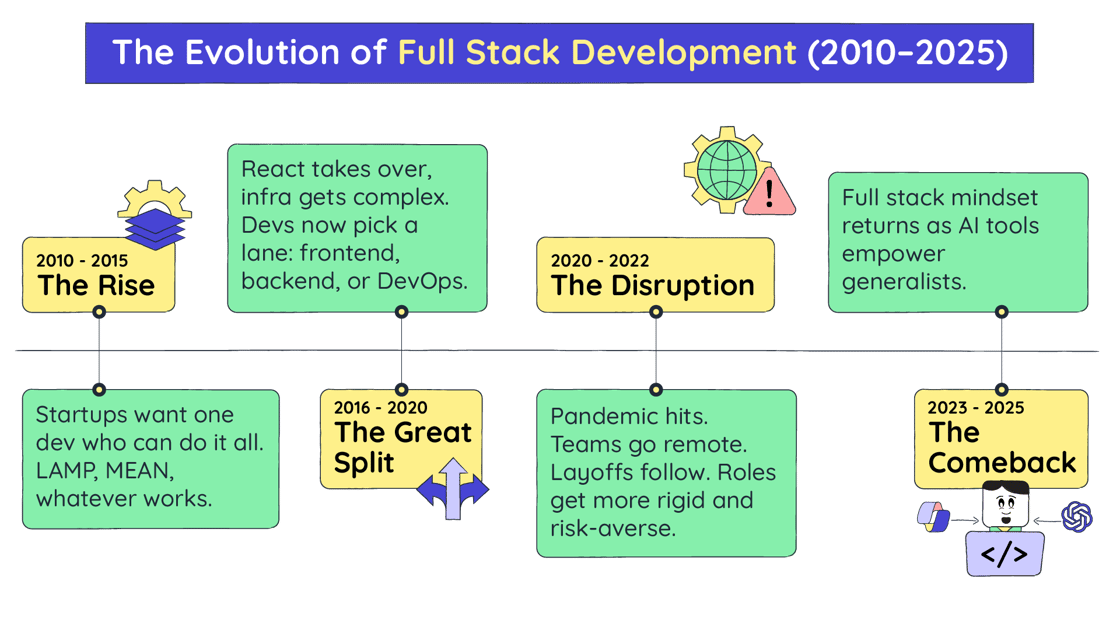Is frontend development dead?
What's happening to frontend + takeaways for developers, PMs, and tech leads.
Ten years ago, specializing was a career superpower.
Today, it's a liability.
In the latest Stack Overflow Developer Survey, only 5.6% of respondents identified as strictly frontend developers. This is a staggering drop from just a few years ago.
What changed? While AI is reshaping how developers work, budget cuts are reshaping how companies hire.
Both forces pushed toward the same outcome: specialization is unsustainable, and full stack is back. Meanwhile, the traditional frontend role is disappearing.
This shift doesn’t just impact engineers. It’s changing how teams hire, architect, and build products. If you’re a PM, tech lead, or founder, this affects you too.
Today, I'll cover:
Why rigid specialization is fading
The return of full stack development
How frontend itself has evolved
What these changes mean for devs, PMs, and tech leads
Let's get started.
The fall of rigid specialization
Being a frontend developer used to be practical. Frameworks were growing, UIs were getting sophisticated, and companies needed experts who could tame the chaos.
But around 2023, the tides shifted:
AI tools (like Copilot and Cursor) lowered the barrier for developers to move between layers.
Hiring budgets tightened, forcing companies to prioritize versatility.
And specialization plummeted. Stack Overflow’s Developer Survey showed the sudden shift.
Between 2020 and 2024, the number of respondents who self-identified as frontend developers declined by over 30%. In this same time frame, respondents who identified as strictly backend also decreased drastically (from 55% to 16.7%).
It’s not that these developers disappeared. Most of them evolved into full stack because the industry demanded it.
The return of full stack
Full stack was incredibly popular when it first hit the spotlight in the early 2010s. But as systems grew more complex, specialization became the more efficient choice, and backend and frontend developers were rewarded for honing their crafts.
Today, thanks to AI and the need for agility, full stack is roaring back. But that doesn't necessarily mean companies want generalists.
Today's ideal web developer is T-shaped, with:
Broad knowledge across the stack: UI, APIs, databases, and cloud infrastructure
Depth in one area
That depth can take different forms:
Frontend depth could mean System Design, performance optimization, and complex state management.
Backend depth could mean understanding distributed systems, database optimization, API design, or cloud infrastructure at scale.
AI tools can fake breadth of knowledge, but depth of knowledge is where engineers really make themselves invaluable.
Frontend has leveled up
It's not just job titles that are changing. Frontend itself has evolved.
Modern frontends aren’t just about HTML, CSS, and JavaScript anymore.
They are dynamic, data-driven, engineered systems designed for:
Handling complex user interactions and massive state
Optimizing every millisecond of performance
Seamlessly communicating with distributed backends
Delivering consistent, reliable experiences across devices
Today’s frontend developers must think like systems architects, giving way to the term Frontend System Design. Frontend System Design involves architecting how entire applications behave, scale, and perform under real-world conditions.
Frontend System Design is far more than styling, and it's no longer a nice-to-have skill; it’s the foundation for real-world, production-grade apps.
It’s why Instagram feels instantly responsive, Netflix buffers less than you expect, and it defines whether users come back to or drop your service.
Recalibrating for the future
The old lines between frontend and backend are fading fast. AI is accelerating this shift, but it can’t replace real architectural thinking.
Those who thrive in this new era will combine breadth across the stack with deep technical judgment.
Developers, here's what this means for you:
Frontend or backend devs: Double down on your strengths, but expand your knowledge across the stack.
Full stack devs: Stay broad, but build real depth in one discipline to be irreplaceable.
And for PMs and tech leads:
Don’t treat frontend as “just UI”; it’s a system, and needs to be designed like one.
Partner with engineers who think architecturally, not just functionally.
Build enough technical fluency to make product decisions that scale.
Want to double down on Frontend System Design? You can get started today with Educative's new hands-on course, Grokking the Frontend System Design.
You’ll learn how to:
Design real-world systems like chat apps, newsfeeds, and streaming platforms
Optimize performance, manage complex state, and apply proven design patterns
Architect modern frontends with strategies like component-driven design and micro frontends
Connect seamlessly to backends using efficient APIs
Apply the REDCAAP framework, a 7-step method for scalable frontend System Design
Whether you're preparing for a System Design Interview or leading the architecture of your next major product, you can use this course to learn how to design frontends that scale for years to come. If you give it a shot, I'd love to hear what you think.
Happy learning!




